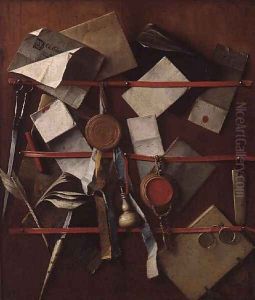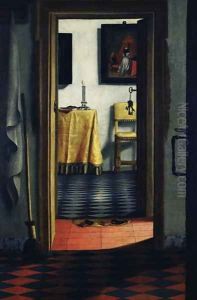(attr.to) Hoogstraten, Samuel van Paintings
Samuel van Hoogstraten was a significant figure in the Dutch Golden Age of painting, recognized for his diverse contributions as a painter, writer, and art theorist. Born in Dordrecht, Netherlands, in 1627, Hoogstraten was immersed in the world of art from a young age. His father, Dirk van Hoogstraten, was a painter, which provided Samuel with an early exposure to painting and artistry. This familial influence deeply shaped his early education and career choices. Hoogstraten initially trained under his father before moving on to study under the tutelage of the renowned painter Rembrandt van Rijn in Amsterdam, an experience that significantly influenced his artistic style and approach.
Hoogstraten's oeuvre is diverse, encompassing genre scenes, portraits, still lifes, and historical paintings, displaying his versatility across different painting genres. However, he is particularly noted for his contributions to the development of perspective and trompe-l'oeil techniques, creating works that play with the viewer’s perception of space and reality. His innovative approach to perspective is most famously exemplified in his 'peepshow' boxes, which are meticulously crafted, three-dimensional dioramas viewed through a peephole, creating an illusion of depth and space.
Beyond his paintings, Hoogstraten also made significant contributions to the art world through his writings. His most notable work, 'Inleyding tot de Hooge Schoole der Schilderkonst: Anders de Zichtbaere Werelt' (Introduction to the Academy of Painting; or, The Visible World), published in 1678, the year of his death, is a comprehensive treatise on painting. In it, Hoogstraten delves into the theory and practice of painting, offering insights into the techniques and philosophical underpinnings of art. This work is especially valuable for its reflections on the role of perspective, making it an essential resource for understanding 17th-century Dutch art.
Throughout his career, Hoogstraten traveled extensively, living and working in various European cities, including Vienna, Rome, and London, which broadened his artistic perspective and exposure. These travels allowed him to study different artistic styles and techniques, further enriching his work. Despite his travels, he eventually returned to his hometown of Dordrecht, where he continued to paint and write until his death in 1678.
Hoogstraten's legacy is multifaceted; he is remembered not only for his artistic achievements but also for his contributions to art theory and education. His works are held in high esteem, featured in major museums and collections worldwide, offering insight into the artistic innovations of the Dutch Golden Age. Through his paintings and writings, Samuel van Hoogstraten has left an indelible mark on the history of art, bridging the practical and theoretical to shed light on the intricate world of 17th-century Dutch painting.

